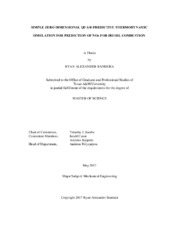| dc.description.abstract | Computational fluid dynamics (CFD) is now a ubiquitous computational tool for engine design and analysis. It is often necessary to provide well-known initial cycle conditions to commence the CFD computations. Such initial conditions can be provided by experimental data. To create an opportunity to computationally study engine conditions where experimental data are not available, a zero-dimensional quasi-predictive thermodynamic simulation is developed that uses a well-established spray model to predict rate of heat release and calculated burned gas composition and temperature to predict nitric oxide (NO) concentration. This thesis details the thermodynamic simulation for diesel engine operating conditions. The goal is to produce an algorithm that is capable of predicting NO emissions as well as performance characteristics such as mean effective pressure (MEP). The simulation uses general conservation of mass and energy approaches to model intake, compression, and exhaust. Rate of heat release prediction is based on an existing spray model to predict how fuel concentrations within the spray jet change with penetration. Rate of heat release provides predicted cylinder pressure, which is then validated against experimental pressure data under known operating conditions. An equilibrium mechanism is used to determine burned gas composition which, along with burned gas temperature, can be used for prediction of NO in the cylinder. NO is predicted using the extended Zeldovich mechanism. This mechanism is highly sensitive to temperature, and it is therefore important to accurately predict cylinder gas temperature to obtain correct NO values. iii The simulation focuses on single fuel injection events, but some multiple injection events are investigated, and improvements to the model to better handle these cases are suggested. | en |


